2018-08-16 - Nº 172
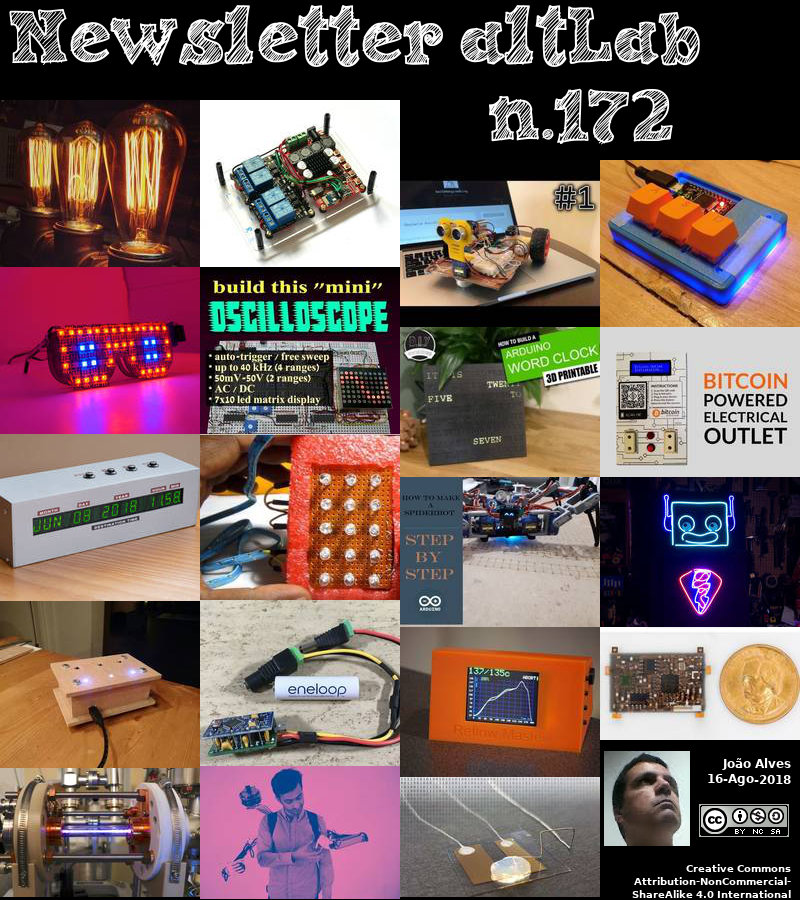
Editorial
Esta é a Newsletter Nº 172 que se apresenta com o mesmo formato que as anteriores. Se gostar da Newsletter partilhe-a!
Todas as Newsletters encontram-se indexadas no link.
Esta Newsletter tem os seguintes tópicos:
Faz hoje anos que nascia, em 1821, Arthur Cayley. Este Matemático inglês desempenhou um papel de liderança na fundação da moderna escola britânica de matemática pura. Ele treinou primeiro como advogado e, desde 1849, passou 14 anos no bar, período durante o qual manteve um interesse pela matemática e publicou cerca de 250 artigos matemáticos. Em 1863, Cayley seguiu sua paixão e iniciou uma nova carreira como professor de Matemática Pura em Cambridge e durante seu mandato publicou 900 artigos e notas cobrindo quase todos os aspectos da matemática moderna. O legado de seu trabalho na geometria n-dimensional foi posteriormente aplicado na física ao estudo do contínuo espaço-temporal. O seu trabalho em matrizes serviu de base para a mecânica quântica desenvolvida por Werner Heisenberg em 1925.
Faz igualmente anos hoje que nascia, em 1845, Gabriel Lippmann. Foi um físico francês que recebeu o Prémio Nobel da Física em 1908 por produzir a primeira chapa fotográfica colorida. Lippmann foi um gigante do seu tempo na pesquisa de física clássica, especialmente em óptica e electricidade. Ele trabalhou em Berlim com o famoso Hermann von Helmholtz antes de se instalar em Paris para dirigir (em 1886) os Laboratórios de Pesquisa Física da Sorbonne até sua morte. As suas invenções incluem um instrumento para medir com precisão as diferenças mínimas em energia eléctrica e o “coleostat” para fotografias celestes firmes e de longa exposição.
Faz também anos hoje que nascia, em 1884, Hugo Gernsback. Este Inventor norte-americano e editor foi em grande parte responsável pelo estabelecimento da ficção científica como uma forma literária independente. Hugo fundou a estação de rádio WRNY, esteve envolvido nas primeiras transmissões de televisão e é considerado um pioneiro em rádio amador. Em 1926, como proprietário de uma revista, a Modern Electrics, ele preencheu um espaço em branco da sua publicação ao lançar o primeiro capítulo de uma série chamada "Ralph 124C 41+". "Ralph" foi um sucesso incrível. A história de 12 partes foi preenchida com todos os tipos de invenções selvagens inéditas em 1926, incluindo televisão (ele é creditado com a introdução desta palavra), iluminação fluorescente, juke boxes, energia solar, televisão, microfilme, máquinas de venda automática e um dispositivo que agora se chama de radar.
Por fim, faz anos hoje que nascia, em 1904, Wendell Meredith Stanley. Este Bioquímico norte-americano recebeu em 1946 (com John Northrop e James Sumner) o Prémio Nobel de Química pelo seu trabalho na purificação e cristalização de vírus, demonstrando assim a sua estrutura molecular. Impressionado pelo sucesso de John Northrop em cristalizar proteínas, Stanley aplicou essas técnicas nos seus extractos do vírus mosaico do tabaco (TMV). Em 1935, ele tinha obtido cristais finos semelhantes a hastes do vírus e demonstrou que o TMV ainda retinha sua infectividade após a cristalização, a primeira de tal purificação de um vírus. No início, alguns cientistas eram cépticos - pensando que os vírus, sendo semelhantes aos organismos vivos convencionais, não poderiam existir na forma cristalina. Stanley então acreditou, incorrectamente, que a proteína era o agente activo do vírus. Durante a Segunda Guerra Mundial, ele trabalhou no isolamento do vírus da influenza e preparou uma vacina contra ele. Em 1936, ele isolou os ácidos nucléicos do vírus mosaico do tabaco, que foram encontrados mais tarde (1955) para causar a actividade viral.
Faz hoje 25 anos que a distribuição de linux Debian foi criada. Quando o falecido Ian Murdock fez o anuncio no grupo de news comp.os.linux.development, "a iminente conclusão de um novo lançamento [...] do Linux, o Debian Linux Release", ninguém esperaria "o lançamento Debian Linux "para se tornar o que hoje em dia é conhecido como o Projeto Debian, um dos maiores e mais influentes projectos de software livre. O seu principal produto é o Debian, um sistema operativo livre (SO) para o seu computador, bem como para muitos outros sistemas que melhoram sua vida. Do funcionamento interno do aeroporto próximo ao sistema de entretenimento do carro e dos servidores na Cloud que hospedam os seus sites favoritos aos dispositivos de IoT que se comunicam com eles, o Debian pode ser usado em todos eles.
Esta semana também ficámos a saber que a NASA tenta, sem sucesso, contacto com o Opportunity Rover desde 10 de Junho, quando uma tempestade de poeira envolvendo o planeta cortou a energia solar do rover de quase 15 anos. Agora que os cientistas acham que a tempestade global de poeira está "decaindo" - o que significa que mais poeira está caindo da atmosfera do que está sendo levantada de volta - os céus podem ficar claros o suficiente para que o veículo movido a energia solar possa recarregar e tente "telefonar". casa. Aguardemos que tenha sucesso.
Na Newsletter desta semana apresentamos diversos projetos de maker.
 João Alves ([email protected])
João Alves ([email protected])
O conteúdo da Newsletter encontra-se sob a licença  Creative Commons Attribution-NonCommercial-ShareAlike 4.0 International License.
Creative Commons Attribution-NonCommercial-ShareAlike 4.0 International License.
Novidades da Semana

25 years and counting
"When the late Ian Murdock announced 25 years ago in comp.os.linux.development, "the imminent completion of a brand-new Linux release, [...] the Debian Linux Release", nobody would have expected the "Debian Linux Release" to become what's nowadays known as the Debian Project, one of the largest and most influential free software projects. Its primary product is Debian, a free operating system (OS) for your computer, as well as for plenty of other systems which enhance your life. From the inner workings of your nearby airport to your car entertainment system, and from cloud servers hosting your favorite websites to the IoT devices that communicate with them, Debian can power it all. Today, the Debian project is a large and thriving organization with countless self-organized teams comprised of volunteers. While it often looks chaotic from the outside, the project is sustained by its two main organizational documents: the Debian Social Contract, which provides a vision of improving society, and the Debian Free Software Guidelines, which provide an indication of what software is considered usable. They are supplemented by the project's Constitution which lays down the project structure, and the Code of Conduct, which sets the tone for interactions within the project." [...]
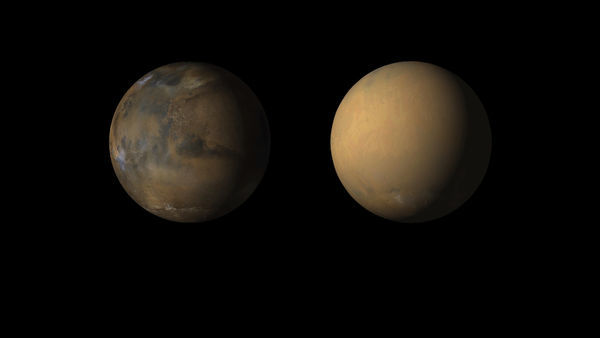
Six Things About Opportunity's Recovery Efforts
"NASA's Opportunity rover has been silent since June 10, when a planet-encircling dust storm cut off solar power for the nearly-15-year-old rover. Now that scientists think the global dust storm is "decaying" -- meaning more dust is falling out of the atmosphere than is being raised back into it -- skies might soon clear enough for the solar-powered rover to recharge and attempt to "phone home." No one will know how the rover is doing until it speaks. But the team notes there's reason to be optimistic: They've performed several studies on the state of its batteries before the storm, and temperatures at its location. Because the batteries were in relatively good health before the storm, there's not likely to be too much degradation. And because dust storms tend to warm the environment -- and the 2018 storm happened as Opportunity's location on Mars entered summer -- the rover should have stayed warm enough to survive." [...]
Outras Notícias
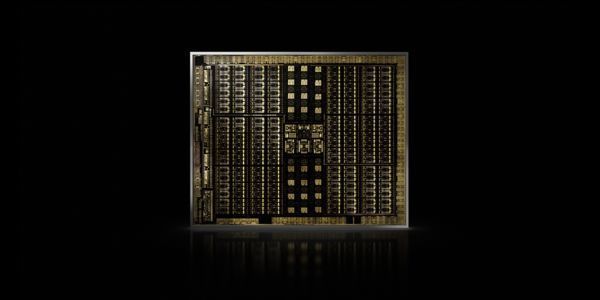
NVIDIA Reinvents Computer Graphics with Turing Architecture
"Hybrid Rendering Fundamentally Changes Computer Graphics by Fusing Real-Time Ray Tracing, AI, Simulation and Rasterization NVIDIA today reinvented computer graphics with the launch of the NVIDIA Turing™ GPU architecture. The greatest leap since the invention of the CUDA GPU in 2006, Turing features new RT Cores to accelerate ray tracing and new Tensor Cores for AI inferencing which, together for the first time, make real-time ray tracing possible. These two engines — along with more powerful compute for simulation and enhanced rasterization — usher in a new generation of hybrid rendering to address the $250 billion visual effects industry. Hybrid rendering enables cinematic-quality interactive experiences, amazing new effects powered by neural networks and fluid interactivity on highly complex models. The company also unveiled its initial Turing-based products — the NVIDIA® Quadro® RTX™ 8000, Quadro RTX 6000 and Quadro RTX 5000 GPUs — which will revolutionize the work of some 50 million designers and artists across multiple industries. “Turing is NVIDIA’s most important innovation in computer graphics in more than a decade,” said Jensen Huang, founder and CEO of NVIDIA, speaking at the start of the annual SIGGRAPH conference." [...]
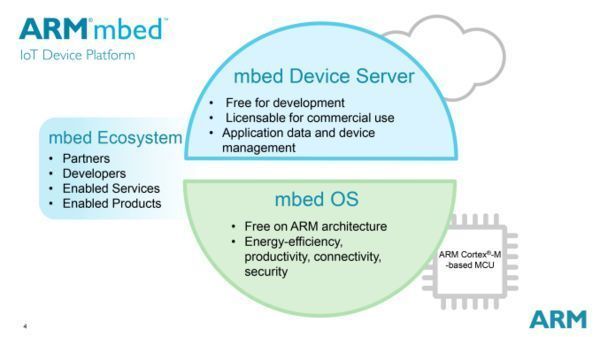
Mbed OS 5.9.5 released
"We are pleased to announce the Mbed OS 5.9.5 release is now available. This is the latest patch release based on the feature set that Mbed OS 5.9 introduces. Summary In this release we have added LPTICKER support for Renesas devices and support for SLEEP in MXRT1050EVK. We have updated mbed-coap to version 4.5.1. This fixes an issue where blockwise observations were not completing. We have also updated CubeF1 for STM32F1 to V1.6.1." [...]
Ciência e Tecnologia
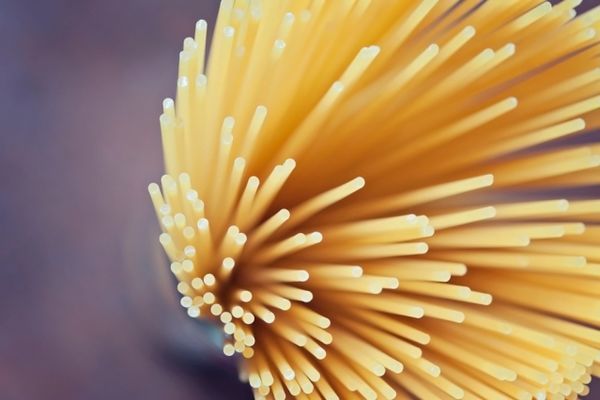
MIT mathematicians solve age-old spaghetti mystery
"It’s nearly impossible to break a dry spaghetti noodle into only two pieces. A new MIT study shows how and why it can be done. If you happen to have a box of spaghetti in your pantry, try this experiment: Pull out a single spaghetti stick and hold it at both ends. Now bend it until it breaks. How many fragments did you make? If the answer is three or more, pull out another stick and try again." [...]
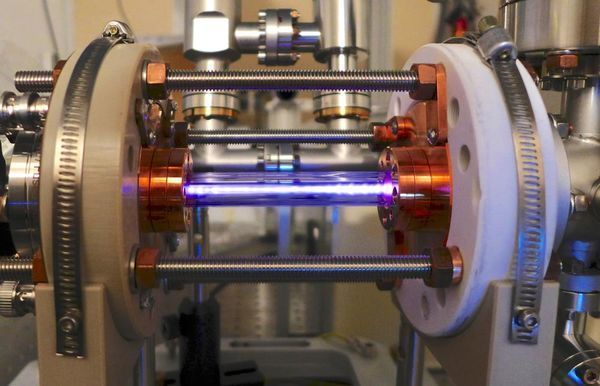
World record - Low-draft electron bunches drive high plasma wakes
"Scientists achieve highest ratio of acceleration to deceleration in plasma wakes yet Scientists at DESY have achieved a milestone towards the usability of novel, plasma-based particle accelerators. Using the electron beam of the PITZ accelerator, the Photo Injector Test facility at DESY's Zeuthen site, DESY physicist Frank Stephan and his group, as part of the LAOLA collaboration, accelerated electrons in a plasma wake with an enhanced ratio between acceleration of the witness and deceleration of the driver beam. This so-called transformer ratio defines the achievable energy gain in such a plasma accelerator. Their results are now being published in the journal Physical Review Letters. Plasma-based particle acceleration is a novel accelerator technology which utilizes the possibility to achieve accelerating field strengths in a plasma which exceed those of conventional accelerators by three orders of magnitude. In the case of the Plasma Wakefield Acceleration scheme, a pair of two electron bunches are shot into an ionized gas (plasma) where the first, highly energetic “driver”-bunch drives a plasma wake." [...]
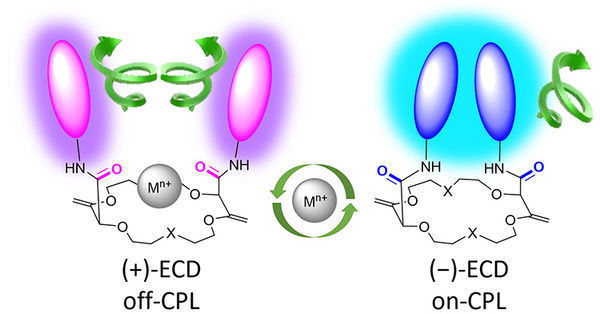
Molecular switch detects metals in the environment
"Researchers from UNIGE have developed a new type of chemical sensor capable of detecting the presence of metals in the environment. An international team, led by researchers from the University of Geneva (UNIGE), Switzerland, has designed a family of molecules capable of binding to metal ions present in its environment and providing an easily detectable light signal during binding. This new type of sensor forms a 3D structure whose molecules are chiral, that is to say structurally identical but not superimposable, like an image and its reflection in a mirror, or like the left and right hands. These molecules consist of a ring and two luminescent arms that emit a particular type of light in a process called Circular Polarized Luminescence (CPL), and selectively detect ions, such as sodium. This research can be read about in Chemical Science. "The luminescent arms of our molecules function like light bulbs that light up or turn off depending on the presence of a positively charged ion, a metal cation," explains Jérôme Lacour, Dean of the Faculty of Science at UNIGE and Ordinary Professor in the Department of Organic Chemistry." [...]
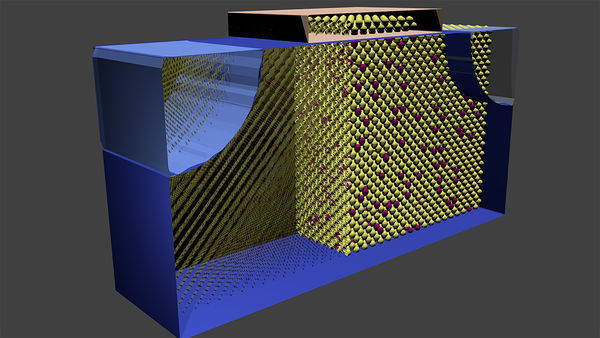
Transistor technology may improve speed, battery life for computers, mobile phones and other electronics
"Purdue University researchers have developed transistor technology that shows potential for improving computers and mobile phones. The researchers created a new technology design for field effect transistors, which are basic switching devices in computers and other electronic devices. Those types of transistors also are promising candidates for next generation nanodevices. They can offer better switching behavior for computers and devices compared with traditional field effect transistors. “Our technology is unique because it merges lasers and transistors,” said Tillmann Kubis, research assistant professor in Purdue's School of Electrical and Computer Engineering, Network for Computational Nanotechnology and Purdue Center for Predictive Materials and Devices. “There is traditionally not a lot of overlap between these two areas, even though the combination can be powerful with the Internet of Things and other related fields.” The combination of the quantum cascade laser and transistor technologies into a single design concept will help manufacturers of integrated circuits who want to build smaller and more transistors per unit area." [...]

Meet the guy with four arms, two of which someone else controls in VR
"These robotic limbs could someday help people work together when they’re far apart. Yamen Saraiji has four arms, and two of them are giving him a hug. The limbs embracing Saraiji are long, lanky, and robotic, and they’re connected to a backpack he’s wearing. The arms are actually controlled remotely by another person, who’s wearing an Oculus Rift VR headset, with which they can see the world from Saraiji’s perspective (cameras linked to the backpack ensure a good view), and wield handheld controllers to direct the non-human arms and connected hands. After the hug, the robotic arms release Saraiji. Then the right hand gives him a high five, and Saraiji smiles." [...]
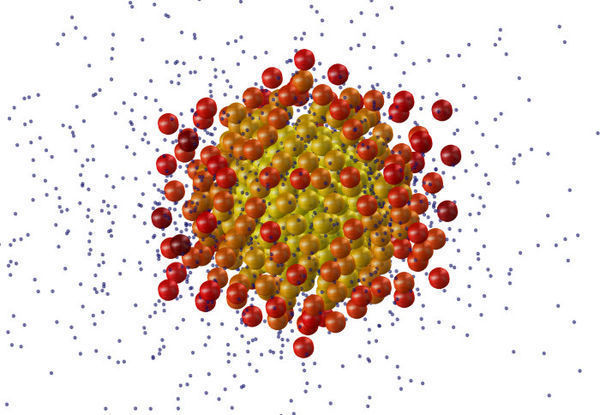
Surprise slow electrons are produced when intense lasers hit clusters of atoms
"Scientists found that relatively slow electrons are produced when intense lasers interact with small clusters of atoms, overturning current theories. Intense laser cluster interactions occur when small clusters of atoms, nanometres (billionths of a metre) in size, are struck with intense lasers. This happens, for example, when imaging biomedical samples on ultrafast timescales. However, the biomolecules can be damaged in this process by radiation. The discovery of slow, low-energy electrons produced by the intense laser cluster interactions provides a missing link in scientists’ understanding of the process, and could explain why biomolecules are damaged. Intense laser cluster interactions were known to produce energetic ions and electrons, but now, in a paper published today in Physical Review Letters, researchers have revealed that relatively slow electrons are also produced in large quantities." [...]

3D Inks that Can Be Erased Selectively
"KIT Scientists Develop Method for the Specific Degradation of Laser-written Microstructures – Paper in Nature Communications 3D printing by direct laser writing enables production of micro-meter-sized structures for many applications, from biomedicine to microelectronics to optical metamaterials. Researchers of Karlsruhe Institute of Technology (KIT) have now developed 3D inks that can be erased selectively. This allows specific degradation and reassembly of highly precise structures on the micrometer and nanometer scales. The new photoresists are presented in the journal Nature Communications (DOI: 10.1038/s41467-018-05234-0). 3D printing is gaining importance, as it allows for the efficient manufacture of complex geometries. A very promising method is direct laser writing: a computer-controlled focused laser beam acts as a pen and produces the desired structure in a photoresist." [...]
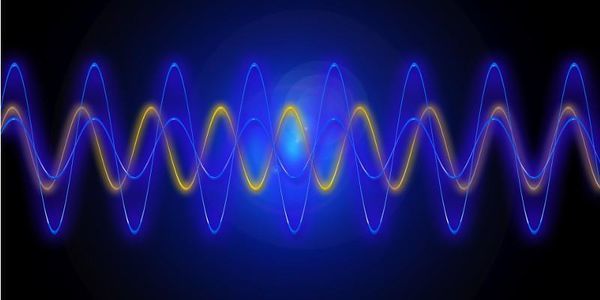
Shining a light on the operation of lasers
"asers are widely used as high power sources of light operating at a specific frequency. But how does this frequency get selected when a laser is turned on, and how quickly? Pioneering engineers using terahertz frequency technology have been able to investigate this process for the first time. Their results will underpin the future development of semiconductor lasers, including those used in public and private sector-owned telecommunications systems. For many years, it has been predicted that operating frequencies within semiconductor lasers stabilise on a timescale of a few nanoseconds (ie a few billionths of a second) and can be changed within a few hundreds of picoseconds (ie thousandths of a nanosecond). Until now though, no detector has been capable of measuring and proving this precisely, and the best results have only been achieved on nanosecond timescales, which are too slow to allow really efficient analysis or to be used to develop the most effective new systems." [...]
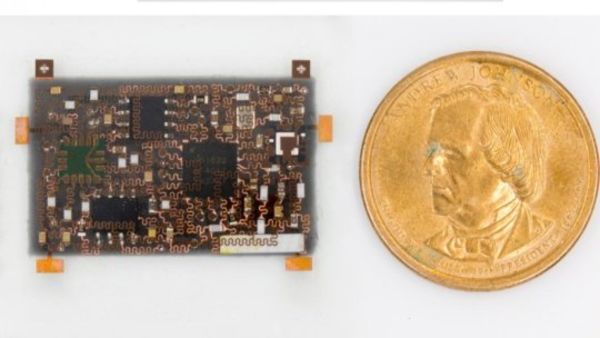
'Building up' Stretchable Electronics to be as Multipurpose as Your Smartphone
"By stacking and connecting layers of stretchable circuits on top of one another, engineers have developed an approach to build soft, pliable “3D stretchable electronics” that can pack a lot of functions while staying thin and small in size. The work is published in the Aug. 13 issue of Nature Electronics. As a proof of concept, a team led by the University of California San Diego has built a stretchable electronic patch that can be worn on the skin like a bandage and used to wirelessly monitor a variety of physical and electrical signals, from respiration, to body motion, to temperature, to eye movement, to heart and brain activity. The device, which is as small and thick as a U.S. dollar coin, can also be used to wirelessly control a robotic arm. “Our vision is to make 3D stretchable electronics that are as multifunctional and high-performing as today’s rigid electronics,” said senior author Sheng Xu, a professor in the Department of NanoEngineering and the Center for Wearable Sensors, both at the UC San Diego Jacobs School of Engineering. Xu was named among MIT Technology Review’s 35 Innovators Under 35 list in 2018 for his work in this area." [...]
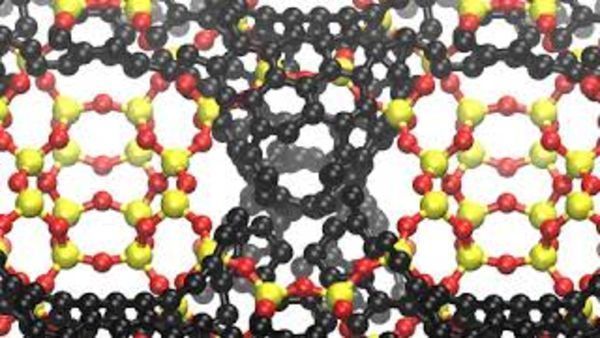
Long-sought carbon structure joins graphene, fullerene family
"The discovery of buckyballs surprised and delighted chemists in the 1980s, nanotubes jazzed physicists in the 1990s, and graphene charged up materials scientists in the 2000s, but one nanoscale carbon structure – a negatively curved surface called a schwarzite – has eluded everyone. Until now. UC Berkeley chemists have proved that three carbon structures recently created by scientists in South Korea and Japan are in fact the long-sought schwarzites, which researchers predict will have unique electrical and storage properties like those now being discovered in buckminsterfullerenes (buckyballs or fullerenes for short), nanotubes and graphene. The new structures were built inside the pores of zeolites, crystalline forms of silicon dioxide – sand – more commonly used as water softeners in laundry detergents and to catalytically crack petroleum into gasoline. Called zeolite-templated carbons (ZTC), the structures were being investigated for possible interesting properties, though the creators were unaware of their identity as schwarzites, which theoretical chemists have worked on for decades. Based on this theoretical work, chemists predict that schwarzites will have unique electronic, magnetic and optical properties that would make them useful as supercapacitors, battery electrodes and catalysts, and with large internal spaces ideal for gas storage and separation." [...]

For ever more efficient optical fibres
"EPFL researchers have taught a type of machine learning algorithm to reconstruct images that became blurred while being transmitted through an optical fiber. The work could increase the amount of information transmitted through telecommunications networks, improve endoscopic imaging used in medical diagnosis and enhance the capacity and quality of optical fibers. “We use modern deep neural network architectures to retrieve the input images from the scrambled output of the fiber,” said Demetri Psaltis, the head of EPFL’s Optics Laboratory, who led the research in collaboration with colleague Christophe Moser from the Laboratory of Applied Photonics Devices. “We demonstrate that this is possible even for fibers 1 kilometer long,” he added, calling the work an important milestone. Their research has now been published in the journal Optica. Deciphering the blur Optical fibers have long been used to transmit information with light." [...]
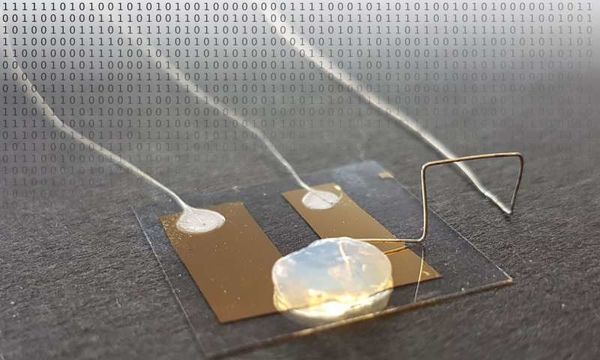
Smallest transistor worldwide switches current with a single atom in solid electrolyte
"At Karlsruhe Institute of Technology (KIT), physicist Professor Thomas Schimmel and his team have developed a single-atom transistor, the smallest transistor in existence. This quantum electronics component switches electrical current by controlled repositioning of a single atom, now also in the solid state in a gel electrolyte. The single-atom transistor works at room temperature and consumes very little energy, which opens up entirely new perspectives for information technology. The transistor is presented in Advanced Materials. Digitization results in a high energy consumption. In industrialized countries, information technology presently has a share of more than 10% in total power consumption." [...]
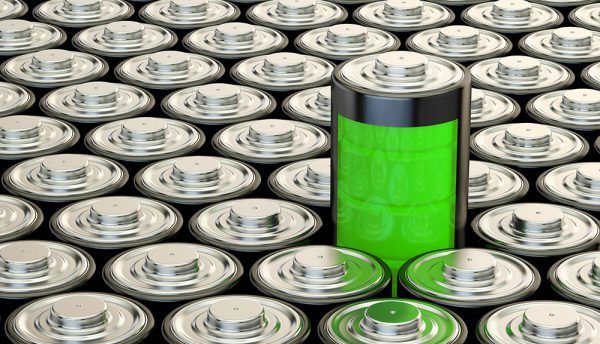
Liquid battery could lead to flexible energy storage
"A new type of energy storage system could revolutionise energy storage and drop the charging time of electric cars from hours to seconds. In a new paper published today in the journal Nature Chemistry, chemists from the University of Glasgow discuss how they developed a flow battery system using a nano-molecule that can store electric power or hydrogen gas giving a new type of hybrid energy storage system that can be used as a flow battery or for hydrogen storage. Their ‘hybrid-electric-hydrogen’ flow battery, based upon the design of a nanoscale battery molecule can store energy, releasing the power on demand as electric power or hydrogen gas that can be used a fuel. When a concentrated liquid containing the nano-molecules is made, the amount of energy it can store increases by almost 10 times. The energy can be released as either electricity or hydrogen gas meaning that the system could be used flexibly in situations that might need either a fuel or electric power. One potential benefit of this system is that electric cars could be charged in seconds, as the material is a pumpable liquid." [...]

Designing Nanocrystals for more efficient Optoelectronics
"New artificial materials for semiconductors used in solar cells or photoelectrochemical cells that are designed from scratch with totally new and tailored properties: this is the latest research topic of Stefan Wippermann, head of the group “Atomistic Modelling“ at the Max-Planck-Institut für Eisenforschung), and his team. They characterized for the first time with atomic resolution a typical material system and are able to set design principles. Their work introduces a new class of nanocrystal-in-glass systems, which increase the efficiency of optoelectronics such as photovoltaics and light-induced water splitting. The Max Planck researchers published their latest findings in the journal Nature Nanotechnology. Nanocrystals can be used as “artificial atoms” to create designer materials for electronic applications and solar energy conversion as they are controllable, potentially non-toxic and earth-abundant. In collaboration with the groups of Dmitri Talapin and Giulia Galli, University of Chicago, wet-chemical techniques were used to synthesize those nanocrystals and assemble them into semiconducting nanocomposites." [...]
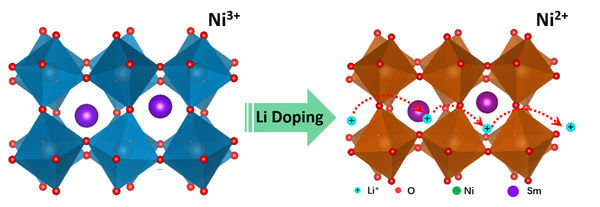
Quantum material is promising 'ion conductor' for research, new technologies
"Researchers have shown how to shuttle lithium ions back and forth into the crystal structure of a quantum material, representing a new avenue for research and potential applications in batteries, “smart windows” and brain-inspired computers containing artificial synapses. The research centers on a material called samarium nickelate, which is a quantum material, meaning its performance taps into quantum mechanical interactions. Samarium nickelate is in a class of quantum materials called strongly correlated electron systems, which have exotic electronic and magnetic properties. The researchers “doped” the material with lithium ions, meaning the ions were added to the material’s crystal structure. The addition of lithium ions causes the crystal to expand and increases the material’s conduction of the ions. The researchers also learned that the effect works with other types of ions, particularly sodium ions, pointing to potential applications in energy storage." [...]
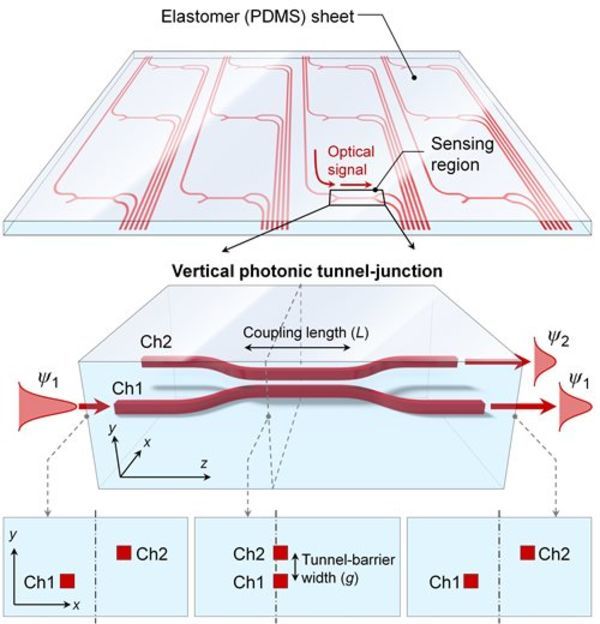
Optical Pressure Detector Could Improve Robot Skin, Wearable Devices and Touch Screens
"A new type of pressure sensor based on light could allow the creation of sensitive artificial skins to give robots a better sense of touch, wearable blood-pressure monitors for humans and optically transparent touch screens and devices. In the Optical Society (OSA) journal Optics Letters, researchers report on a sensor that detects pressure by analyzing changes in the amount of light traveling through tiny tunnels embedded in polydimethylsiloxane (PDMS), a common type of silicone. The flexible, transparent device is sensitive to even gentle pressure and is less prone to failure compared to previous types of pressure sensors. It also should be feasible to incorporate the embedded optical sensors across a large surface area, researchers say. “The silicone sheet can be placed on display panels to enable touch screens, or can be wrapped on robot surfaces as an artificial skin layer for tactile interactions,” says Suntak Park, Electronic and Telecommunications Research Institute, Daejeon, South Korea. “Considering that PDMS is a very well-known bio-compatible, non-toxic material, the sensor sheet may even be applied on or inside the human body, for example, to monitor blood pressure.” Measuring pressure distribution over a curved surface can be important in research areas such as aerodynamics and fluid dynamics." [...]
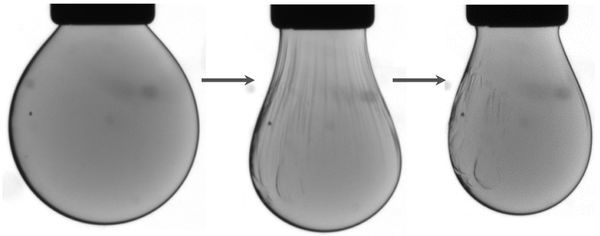
Scientists 'Squeeze' Nanocrystals in a Liquid Droplet Into a Solid-Like State - and Back Again
"A team led by scientists at the U.S. Department of Energy’s Lawrence Berkeley National Laboratory (Berkeley Lab) found a way to make a liquid-like state behave more like a solid, and then to reverse the process. They put a droplet of a liquid containing iron oxide nanocrystals into an oily liquid containing tiny polymer strands. They found that a chemical additive in the droplet can compete with the polymer – like a tiny tug of war – on nanoparticles at the intersection of the liquids. They were able to cause the nanoparticles assembled here to jam, making it act like a solid, and then to unjam and return to a liquid-like state by the competitive push-pull action of the polymer and the additive. “The ability to move between these jammed and unjammed states has implications for developing all-liquid electronics, and for interacting with cells and controlling cellular functions,” said Tom Russell of Berkeley Lab’s Materials Sciences Division, who co-led the study with Brett Helms, a staff scientist at Berkeley Lab’s Molecular Foundry. The Molecular Foundry is a DOE Office of Science User Facility that specializes in nanoscience research." [...]
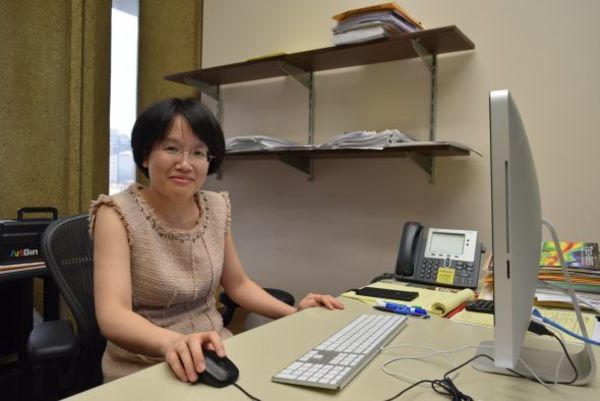
Researchers put a new spin on cooling electronic hotspots
"The longevity of electronic devices is tested in many ways as they endure the rigors of daily usage. Even when they are treated with the utmost care, they still have a major challenge to overcome — the removal of heat. To alleviate this problem, Junxia “Lucy” Shi, assistant professor of electrical and computer engineering, and her team of researchers in the Advanced Semiconductor Materials and Devices Laboratory at UIC are focusing on using a novel method for cooling hotspots in electronics and capturing the wasted heat to use to power the devices. The new technique additionally has the potential to expand the longevity of electronic components. The results of their research were recently published in the prestigious journals Scientific Reports and Physical Review Materials. Electronic devices are getting miniaturized and produce a lot of heat when they carry currents." [...]
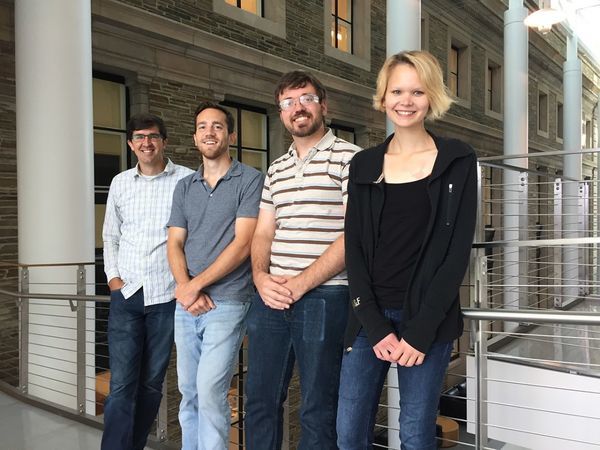
On-demand polymers may yield designer materials
"Researchers at Cornell are devising a method for creating new polymers in much the same way that a jewelry maker creates a beaded necklace – with the beads strung in a precise, controlled way. The lab of Brett Fors, assistant professor of chemistry and chemical biology, has experimented in the past with creating “designer polymers” using two photocatalysts. The process alternates the binding of sub-units (monomers), when either blue or green light was shown on them. The team has taken that approach to the next level in a paper just published in ACS Central Science. For this work, Fors and colleagues used blue light to bind one type of monomer, and a chemical stimulus to connect the other. By toggling between the light or the chemical additive, and controlling how long the stimulus was applied, they could selectively choose which subunit was added to the growing polymer molecule – like beads on a necklace." [...]
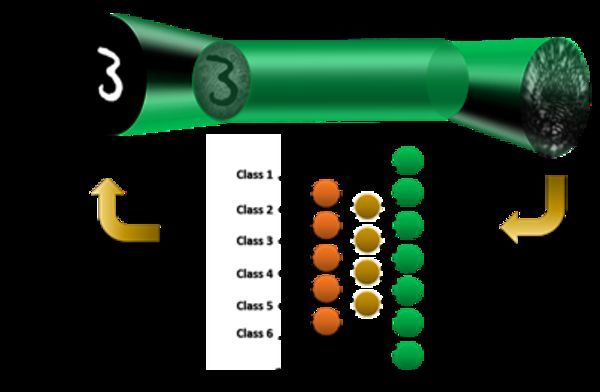
Machine Learning Technique Reconstructs Images Passing through a Multimode Fiber
"Through innovative use of a neural network that mimics image processing by the human brain, a research team reports accurate reconstruction of images transmitted over optical fibers for distances of up to a kilometer. In The Optical Society’s journal for high-impact research, Optica, the researchers report teaching a type of machine learning algorithm known as a deep neural network to recognize images of numbers from the pattern of speckles they create when transmitted to the far end of a fiber. The work could improve endoscopic imaging for medical diagnosis, boost the amount of information carried over fiber-optic telecommunication networks, or increase the optical power delivered by fibers. “We use modern deep neural network architectures to retrieve the input images from the scrambled output of the fiber,” said Demetri Psaltis, Swiss Federal Institute of Technology, Lausanne, who led the research in collaboration with colleague Christophe Moser. “We demonstrate that this is possible for fibers up to 1 kilometer long” he added, calling the work “an important milestone.” Deciphering the blur Optical fibers transmit information with light. Multimode fibers have much greater information-carrying capacity than single-mode fibers." [...]

For UW physicists, the 2-D form of tungsten ditelluride is full of surprises
"The general public might think of the 21st century as an era of revolutionary technological platforms, such as smartphones or social media. But for many scientists, this century is the era of another type of platform: two-dimensional materials, and their unexpected secrets. These 2-D materials can be prepared in crystalline sheets as thin as a single monolayer, only one or a few atoms thick. Within a monolayer, electrons are restricted in how they can move: Like pieces on a board game, they can move front to back, side to side or diagonally — but not up or down This constraint makes monolayers functionally two-dimensional. The 2-D realm exposes properties predicted by quantum mechanics — the probability-wave-based rules that underlie the behavior of all matter. Since graphene — the first monolayer — debuted in 2004, scientists have isolated many other 2-D materials and shown that they harbor unique physical and chemical properties that could revolutionize computing and telecommunications, among other fields." [...]
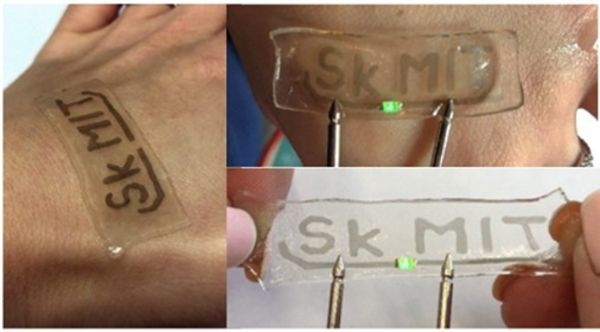
Skoltech and MIT develop simple hydrogel modification method, paving the way to highly stretchable and transparent electronics
"Scientists from the Skolkovo Institute of Science and Technology (Skoltech) and the Massachusetts Institute of Technology (MIT) have proposed a novel method for the fabrication of highly transparent, electrically conductive, stretchable tough hydrogels modified by single-walled carbon nanotubes (SWCNTs). The results of the study have been published in ACS Applied Materials & Interfaces. SWCNT/hydrogel-based patterned circuit pictured in three ways: attached to human skin, relaxed, and stretched by 50 percent. Hydrogels are novel soft materials that have made possible or improved upon an array of modern technologies, such as tissue engineering, drug delivery, biomedical devices, stretchable/bio-integrated electronics and soft robotics. Furthermore, hydrogels that have similar physiological and mechanical properties as human skin are ideal materials for effective bio-integration of such electronics devices. Electrically conductive hydrogels (ECHs) are attracting much interest in the field of biomaterial science due to their unique properties." [...]
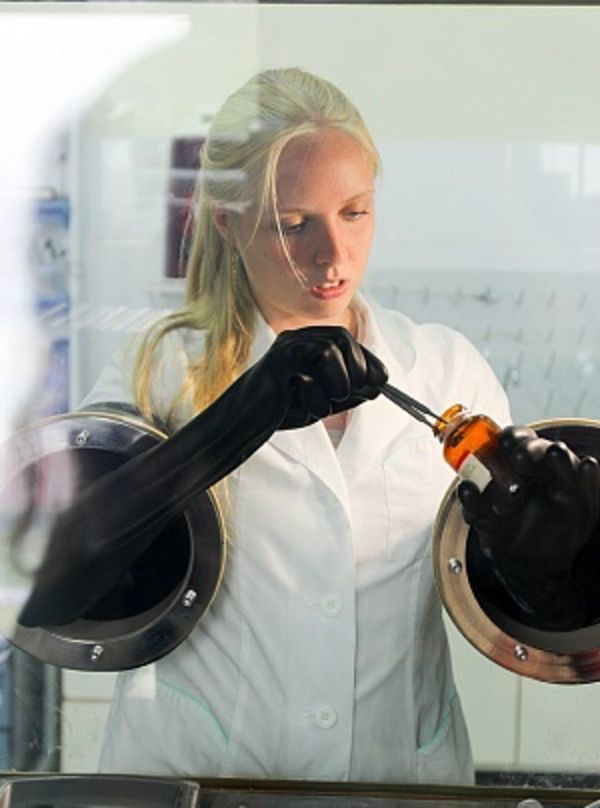
Patented a new type of electrochemical cell
"Employees of the Faculty of Chemistry and the Faculty of Materials Science of the MVLomonosov Moscow State University patented an electrochemical cell that allows studying chemical processes in battery materials, using highly sensitive methods of surface analysis. The development will make it possible to understand the processes that arise when using lithium-air batteries. This type of battery with the same mass has 5 times more capacity than the widely used lithium-ion batteries. To increase the efficiency of batteries, scientists around the world suggest using new chemical reactions, which, leaking when charging and discharging the battery, allow for a higher specific energy storage. One of the most promising alternatives to the most common now lithium-ion batteries are lithium-air elements. Lithium-air batteries produce electricity literally from the air: the principle of their operation is based on the oxidation of lithium by air oxygen to lithium peroxide Li2O2." [...]
Projetos Maker
Diversos Projetos interessantes.
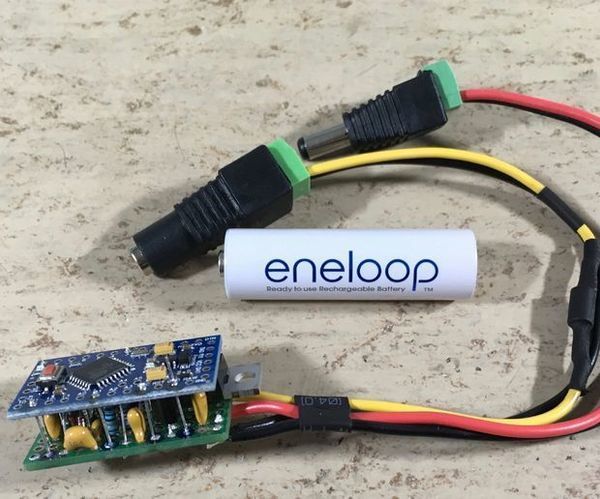
DIY Arduino PWM5 Solar Charge Controller (PCB Files and Software Included)
"A few years ago, Julian Ilett designed the original, PIC microcontroller based "PWM5" solar charge controller. He also experimented with an Arduino based version. You can find his videos here: https://www.youtube.com/channel/UCmHvGf00GDuPYG9D... according to Julians schematic, arduined.eu designed a very small version, based on the 5V, 16MHz Arduino Pro Mini: https://www.arduined.eu/arduino-solar-charge-cont... After I already designed and built two MPPT buck solar chargers, I wanted to try this very simplistic design. " [...]
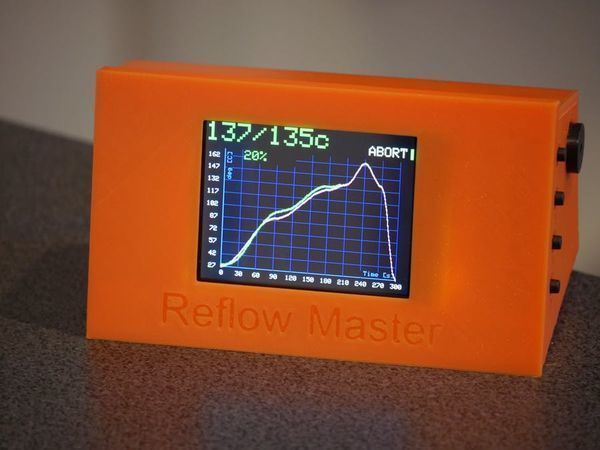
Reflow Master
"An easy to use graphical reflow controller for your toaster oven! Reflow Master really started out as a microcontroller-based graphing experiment... I wanted to visualise the temperature in my toaster oven when I manually reflowed my PCBs. I had a K-Type probe in my oven connected to my digital multimeter, and though I could see the temperature, unless I also used a stopwatch, I had no real idea of how long I was reflowing for and at what temperature... it was VERY scientific. So I thought about using a MAX31855 module connected to a micro-controller to read the temp from my probe and simply drawing this as a graph of temperature over time on a small TFT screen also connected to the micro-controller. " [...]
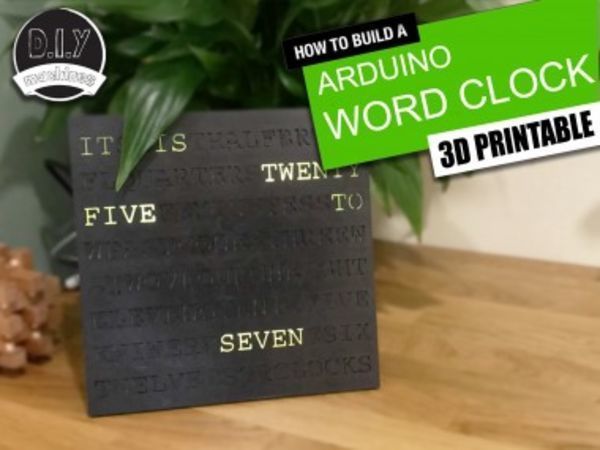
Word Clock - Customisable And Easy To Build
"My partner saw a clock in a shop that told you the time by lighting up words to write a full written sentence from what seemed a jumble of random letters. We liked the clock, but not the price - so we decided to make one of our own design. " [...]
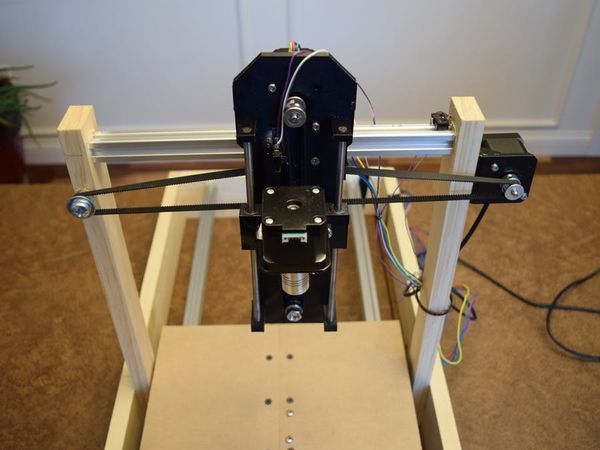
DIY Universal CNC Machine
"Make a fully-functioning CNC machine that can accept different tools for less than $150 by using parts from DFRobot and Banggood. As a serious maker, I have several CNC machines, including two 3D printers and a CNC router. But what if I wanted something else, like a laser engraver or a PCB milling machine? So I set off to do just that: build an inexpensive CNC machine that could have many different attachments, all while controlled through a simple interface of G-code. " [...]
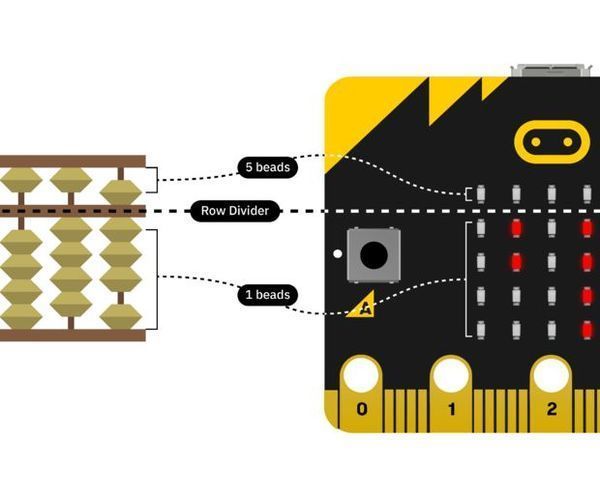
Micro:bit: Displaying Values Like an Abacus
"The Micro:bit is a nifty micro-controller unit for beginners learning about physical computing. It is rather simple to connect different sensors to one of its analog pins and use it to control an output. However, for those familiar with this device, debugging sensor values (particularly analog sensors like photoresistors) can be quite tricky. Establishing a USB serial connection between the micro:bit and a laptop is not straightforward; and using Bluetooth to transmit messages to a mobile app can be rather finicky too. Perhaps the most common way to debug sensor values when using the Micro:bit is to print the values onto the 5x5 on-board LED matrix. Waiting for the numbers to scroll across the screen can be frustratingly slow, and difficult to read (for me at least!)." [...]
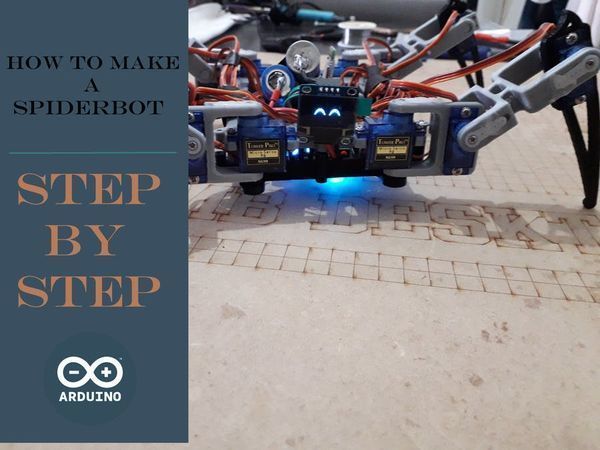
Arduino Spider Robot
"Here is a step by step guide to making a "crawler robot." Hey guys! Here is a new tutorial to guide you step by step while making this kind of super amazing electronic projects, which is the "crawler robot" also known as a "spider robot" or a "quadruped robot." Since everybody noticed the high speed evolution of robotics technology, we decided to take you guys to a higher level on robotics and robot making. we started a while ago by making some basic electronic projects and basic robot like PICTO92 the line follower robot in order to make you a bit familiar with the electronic stuff and find yourself able to invent your own projects. Moving to another level, we've started with this robot which is a basic one in the concept but it will become a bit complicated if you get deeper in its program." [...]
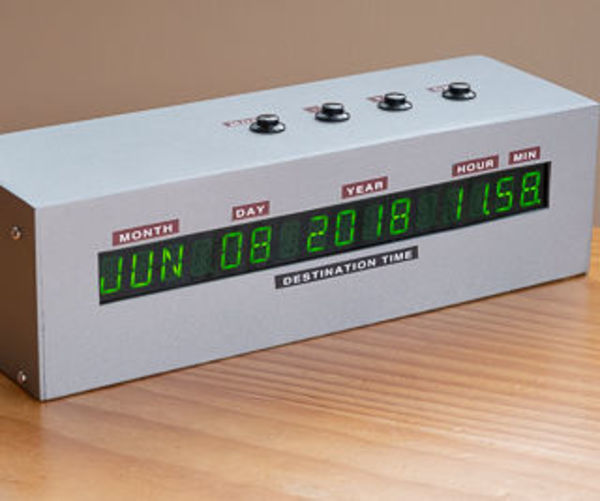
A Back to the Future Clock
"This project started life as an alarm clock for my son. I made it to look like the time circuit from Back to the Future. The display can show the time in various formats, including the one from the movies of course. It's configurable via the buttons on top of the enclosure but also via a web page served by the Raspberry Pi Zero inside. In one of the display modes it will show the local weather (from my Arduino-powered weather station) as well as the forecast and any daily reminders, configured via the web interface. It also has audio thanks to a DAC and will stream music using the AirPlay protocol." [...]

#1 Avoiding Obstacle Robot
"This robot avoids obstacles in its way by using the ultrasonic ranging sensor HC-SR04. This sensor allows the robot to sense any object in front of it. In combination with this, I used the L298N H-Bridge to control the wheels of the robot. When an object is detected in close proximity, the robot will stop, go in reverse, and look for a clear path with the help of the ranging sensor. " [...]
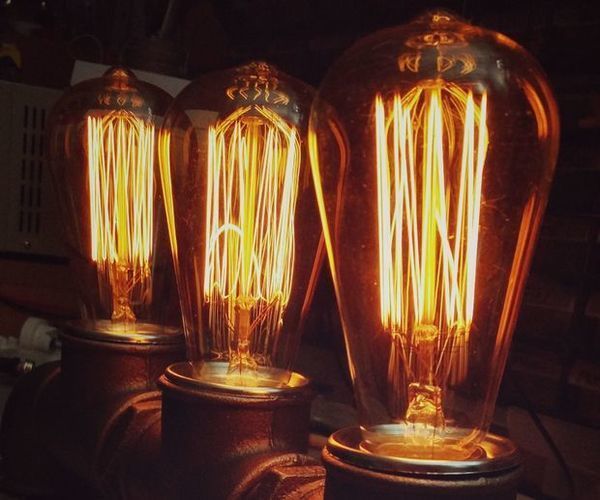
Edison Lamp Dimmer 230V Arduino IRDA Remote Control
"In this instructable I show You how to make 230V dimmer based on Arduino.I use remote controller of my Samsung TV, but it's not necesary. Take a look at YouTube video embedded above. In nex steps I describe shortly how to build a circuit. " [...]

Run Stepper Motor Without a Driver
"In this instructable, i will teach you how to run a stepper motor continuously at high speed without a driver circuit or arduino or AC power supply.Also, by interchanging the wirings, you can run it in both clock-wise & counter clock-wise directions. This method is applicable for 6-wire stepper motor. " [...]
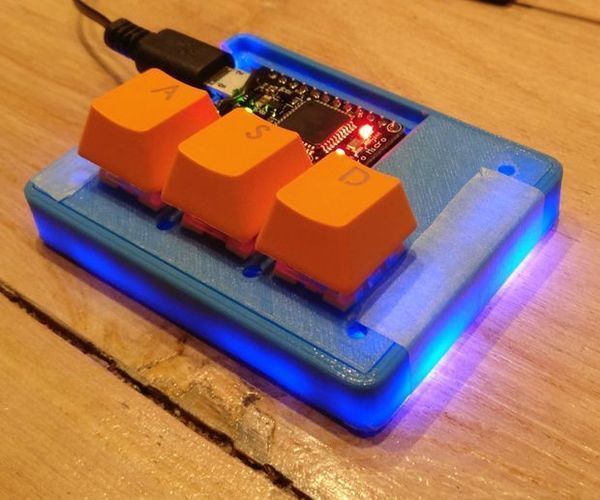
Osu! Keyboard
"I recently started playing a rhythm game called osu! and after seeing a video of a commercial mini keyboard I thought it would be a fun project to design one myself. Not long after that I decided it would be a good idea to put it on instructables as my first project. If you want to replicate this project exactly to the last instruction then be my guest, but some of the desicions I made are not based on lowest price or best quality. Some components are chosen almost purely because i had them lying around. If you can handle it I would encourege you to customize your project." [...]
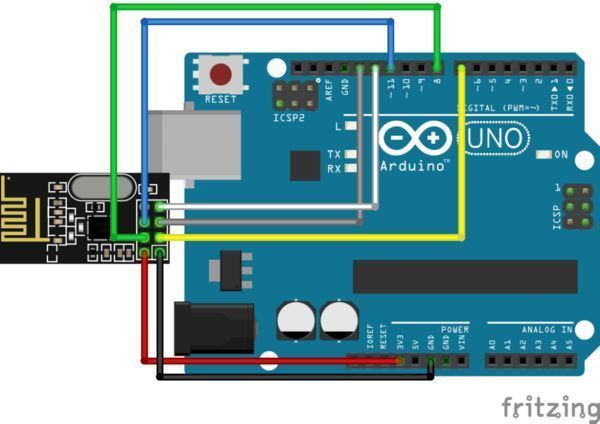
Communication between two Arduinos using NRF24L01
"While building Arduino or any other microcontroller platform project over time the need will arise to establish communication between two of the Arduino boards or microcontrollers for data exchange and/or control. This communication could be achieved using either wired or wireless process. For wireless communication between devices, quite a number of options exist including WiFi, GSM/GPRS, Bluetooth, RF and more recent technologies like LoRaWAN among others. All of these communication protocols have their pros and cons and the situation is in which they are the best fit. For mid-range communication between two microcontrollers, for example, one of the most suitable communication protocol is RF (radio frequency) as it has a good cost to performance ratio and a very good communication range can be attained using certain modules. Today, we will look at the radio frequency based communication between microcontrollers using one of the most popular RF communication modules; the NRF24LO1 communication module." [...]

Bitcoin Powered Electrical Outlet
"A smart electrical outlet that allows customers to rent electricity by paying with Bitcoins. Project Idea Bitcoin and blockchain technology opened a whole lot of opportunities for paying for goods and services but the catch was that it wasn't fully automated because it lacked easy hardware integration support. However, it got easier with the release of the Koyn library. In short, the Koyn library allows your hardware like Arduino compatible boards to receive and send Bitcoin payments. One application model for Bitcoin that interests me is pay per service, and one of many applications I decided to get my hands dirty on is renting electricity. So, I started building an electrical outlet that is powered by Bitcoin." [...]

Inside the die of Intel's 8087 coprocessor chip, root of modern floating point
"Looking inside the Intel 8087, an early floating point chip, I noticed an interesting feature on the die: the substrate bias generation circuit. In this article I explain how this circuit is implemented, using analog and digital circuitry to create a negative voltage. Intel introduced the 8087 chip in 1980 to improve floating-point performance on 8086/8088 computers such as the original IBM PC. Since early microprocessors were designed to operate on integers, arithmetic on floating point numbers was slow, and transcendental operations such as trig or logarithms were even worse. But the 8087 co-processor greatly improved floating point speed, up to 100 times faster. The 8087's architecture became part of later Intel processors, and the 8087's instructions are still a part of today's x86 desktop computers.1 I opened up an 8087 chip and took die photos with a microscope yielding the composite photo below." [...]
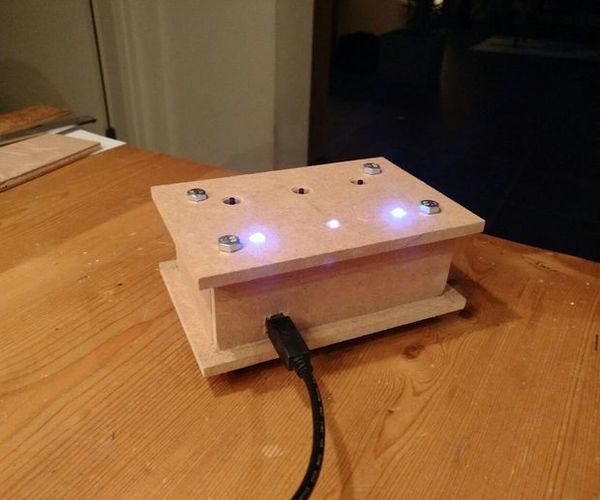
Reaction Tester
"With this buttongame you can test your reaction. What you need: 1x Arduino Uno 1x Breadboard 1x Buzzer (5V) 3x LED (I used the color blue, but you can pick your own colour/colours) 3x Buttons 1x MDF (or other material you want to use to build your housing)" [...]
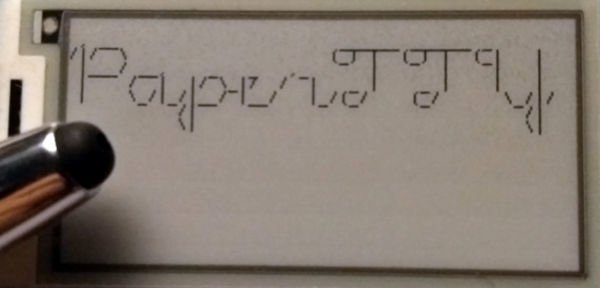
PaperTTY - Python module to render a TTY on e-ink
"This is an experimental command-line driven Python module to render the contents of a Linux virtual terminal (/dev/tty[1-63]) or standard input onto a Waveshare e-Paper display. Note: I just finished this and probably forgot something, so 'caveat utilitor'. Note: I am also not affiliated with Waveshare in any way. " [...]

DIY Arduino Nano !
"In this instructable, I will show you how to make your very own Arduino Nano. The Arduino Nano is a small & breadboard-friendly based on the ATmega328P Chip. It has more or less the same functionality of the Arduino Duemilanove but in a different package. It lacks only a DC power jack and works with a Mini-B USB cable instead of a standard one. I would like to Thank Arduino for their contributions to the community and a huge Thanks for keeping it Opensource So let's get Started! " [...]

Weather Station: ESP8266 With Deep Sleep, SQL, Graphing by Flask&Plotly
"Would that be fun to know the temperature, humidity, or light intensity on your balcony? I know I would. So I made a simple weather station to collect such data. The following sections are the steps I took to build one. Let's get started! When I planned to build a weather station, I was dreaming to have a full-fledged weather station that has wind speed, rain measurement, full-spectrum solar sensor, but turned out, that would not be cheap, and the purchase cost could end up at least $100." [...]
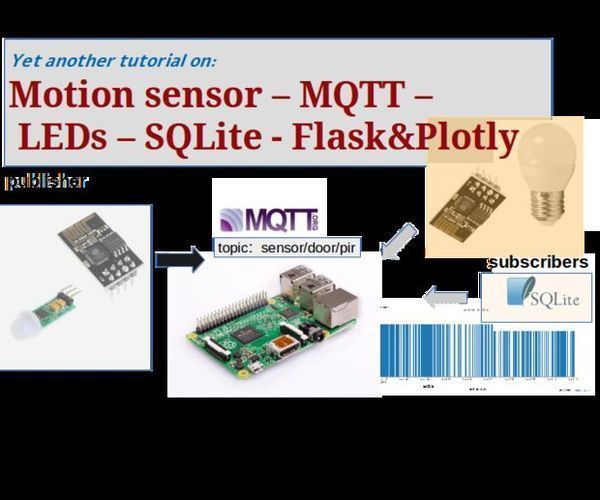
PIR With ESP8266 and MQTT
"Well, this is yet-another motion sensor summary. A well-written tutorial from Adafruit is linked at the end of step 1. This tutorial is the part 2 on the topic of current limiting for LEDs, MQTT, and motion sensor. Part 1 is here. PIR (Passive infrared sensor) or motion sensor is as its name implied detects a heat source that moves. Human, dog, cat moving across the front of the sensor triggers a HIGH signal." [...]

Auto-switching Bluetooth Amplifier
"In my front room, I have some big speakers and an amplifier connected to my TV. However sometimes, I don't want the TV on, and don't want the big clunky amplifier - I just want some background music, played off my phone, that I can turn on and control wirelessly. That's a problem - because the amplifier expects to be connected directly to the speakers. The only option would be to leave the amplifier on, or to somehow control mains voltages from signals on a small Bluetooth receiver. In this instructable you'll modify a SANWU Bluetooth Audio Amplifier so that it'll control a set of 4 relays. Whenever the Bluetooth amplifier needs to play music, it'll switch them over." [...]

DIY RGB LED Goggles
"Its a calm Sunday afternoon and youre wandering by the road lost in thought of what to have for dinner. Suddenly the glaring Sun pops up from behind the clouds breaking your chain of thoughts by its scorching heat. How amazing it would be if you had a pair of sunglasses with controllable shades that you could control as per your wish and avoid the burning Sun! And, apart from coming to the rescue during the day, what if it could also make you party-ready in the night?What if we told you CAN make such sunglasses, right here, right NOW?Sounds incredible, right? So, what are you waiting for? Time to show the Sun whos the real boss AND become the centre of attraction of every party you go to!" [...]
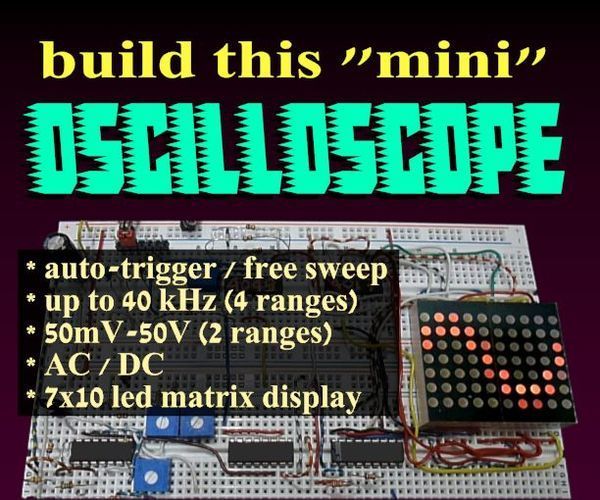
DIY Mini Oscilloscope
"Build this small oscilloscope. Frequency range is up to 40KHz(25uS full screen) In 4 selectable ranges. Input voltage is between 50mVpp and 50Vpp in 2 selectable ranges. Gain is adjustable between 1 and 100. Accepts AC or DC input . Auto-trigger sweep function to "freeze" the wave display." [...]

Arduino 5X3 LED Matrix to Run Alphabets
"I have made an LED matrix to Run Alphabets A-Z in a loop. It was a 3x5 LED matrix and controlled by an Arduino nano programming board. Check out the steps and also the DIY video below. (The sponsors of the video is JLCPCB, a PCB manufacturing company, where I got my PCB design manufactured. you can find them here: www.jlcpcb.com . You may make a PCB board, or use a dot board or bread board depending on your preferences." [...]

An Arduino-controlled turntable for 3D scanning
"Many DSLR cameras can be operated with a simple infrared signal, making them perfect targets for Arduino control. Travis Antoniello took advantage of this with his brilliantly simple 3D scanning rig. Electronics are handled by an Arduino Uno, which commands a stepper motor to rotate a scanning platform 10 degrees per photo. After rotation, it stops for a set amount of time to let scanned objects settle, and triggers the camera, a Nikon D3200, via an infrared LED. It then repeats this process over and over until a full set of photos is taken. Code for the build can be found on GitHub, and the device’s 3D-printed components are available on Thingiverse." [...]
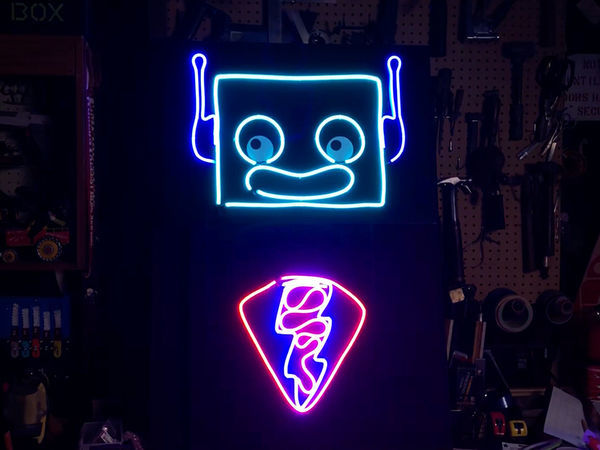
Neon LED Signs
"Make your own neon-style signs without any of the glass, gas, and high voltage! These neon-like LED strips have a great look, are easy to shape and splice, and you can drive them with just 9V to 12V DC. We'll learn how to control them for blinking and animation using a microcontroller and a Darlington transistor driver. " [...]
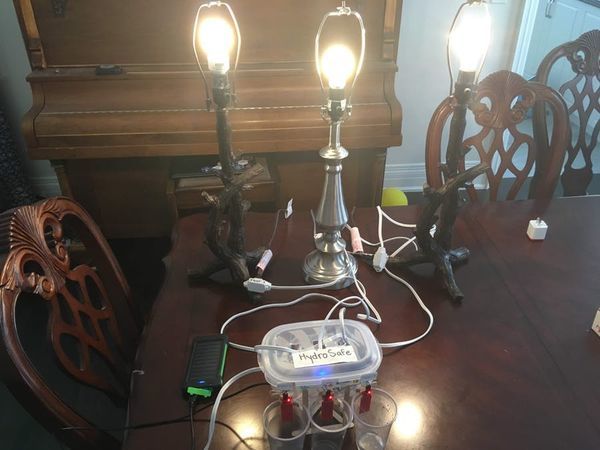
Smart Home Electrical Distribution for Floods
"This hack is a proof of concept that shuts off power only to the level of the house that has been flooded, allowing for normal use elsewhere Story I recently got to know a person from Fredericton, New Brunswick, Canada. Just this past year, there was a record breaking flood there, and when I asked her about it, she gave me an eye-opening account about how it has affected her life. As global warming continues to progress, flooding has gone from a rare occurrence to a commonplace issue in New Brunswick. This past May, the water level rose around 5.8 meters, which was never seen since 1973. Citizens were stranded, public services were cancelled, and many had to relocate for weeks. What struck me was the fact that a huge number of people were negatively impacted even if their home was still partially flood-free." [...]
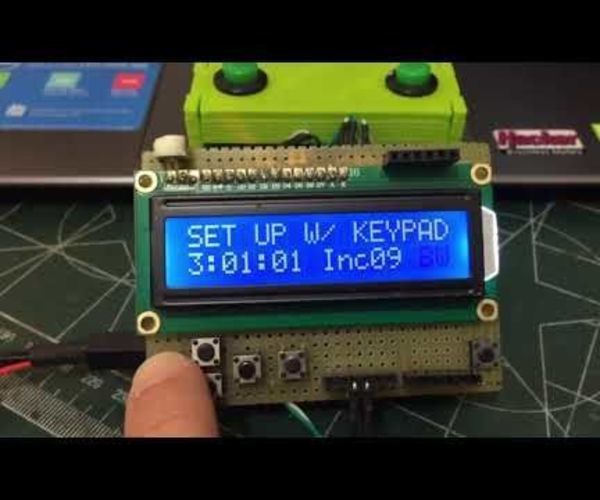
Simple Arduino Chess Clock
"When I thought of doing a Chess Clock with Arduino, the goal was to build using simple programming without use class and work with the AVR register. The base used was Arduino Reference. The most difficult thing was to manipulate the timer using only the Arduino millis (). The idea is the project can be useful by the beginner students of the Arduino. " [...]

Current Meter, Network Frequency and Non-invasive Power
"In this post we will see how to measure the current frequency and power with a non-invasive current sensor SCT-13-50, a dual amplifier LM358. The most interesting thing about this project is that we can measure the current without having to open the circuit, because the sensor sct013-50 is very similar to an ampirometric clamp. It must be taken into account that only one of the cables must be passed to make the measurement, because if we pass the two conductors we will obtain an erroneous reading. " [...]
That's all Folks!


